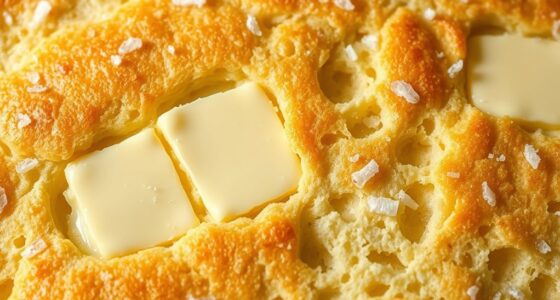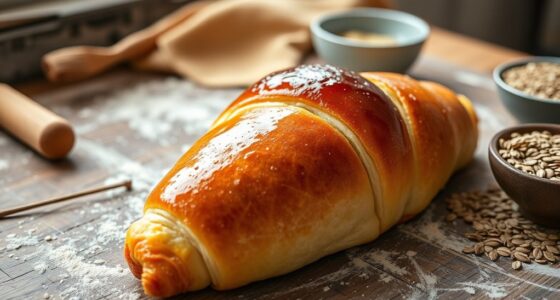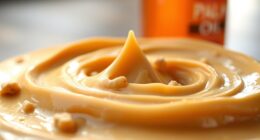To make homemade butter croissants from scratch, start by combining flour, sugar, yeast, and salt. Mix in cold, cubed butter, then add cold milk to form a shaggy dough. Chill it for at least an hour. Next, roll and fold the dough several times to create layers. Shape the croissants and proof them until doubled. Finally, bake at 425°F for about 18 minutes. You'll want to perfect your technique, so let's explore the steps in more detail.
Key Takeaways
- Start by preparing the dough with flour, sugar, yeast, salt, cold milk, and cubed butter, then chill for at least 1 hour.
- Roll the chilled dough into a rectangle, fold it into thirds, and repeat this process 4-5 times, chilling between each turn.
- Shape the dough into croissants and proof them in a warm area until they double in size, about 1.5 to 2 hours.
- Preheat the oven to 425°F (218°C), brush the croissants with egg wash, and bake for about 18 minutes until golden brown.
- Allow the baked croissants to cool for 10 minutes before serving for the best flavor and texture.
History
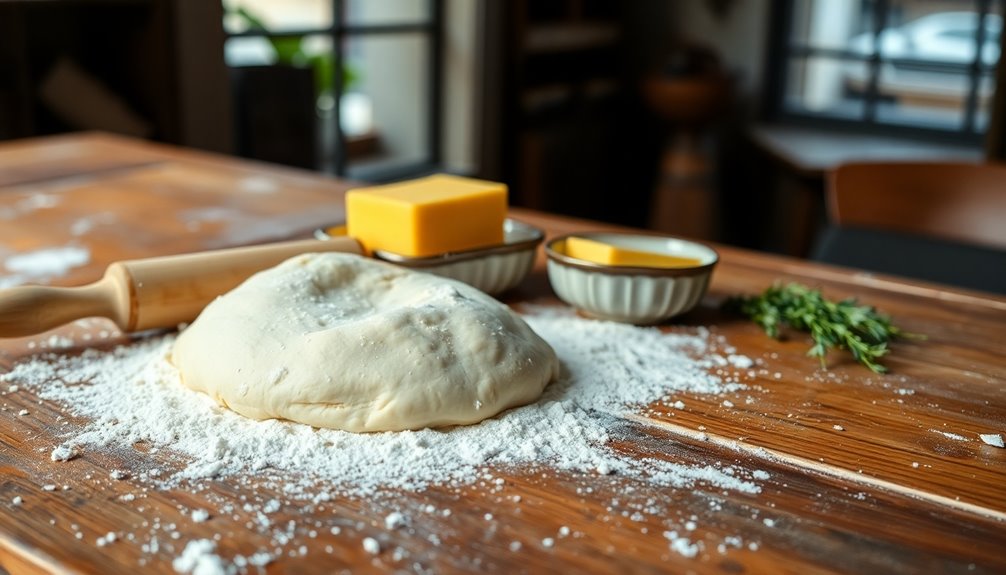
The history of croissants is fascinating, especially when you consider their journey from Austria to France.
It all began in the 13th century with the popular crescent-shaped bread known as "kipferl." When this delicacy made its way to France, it underwent a transformation.
By the 19th century, the modern croissant emerged, thanks to the rise of French pastry culture. The name "croissant" reflects its iconic crescent shape.
Influenced by the Viennese tradition, the art of baking croissants involves lamination, which creates those delightful flaky layers. This technique emphasizes the use of butter, making each bite rich and satisfying.
Recipe
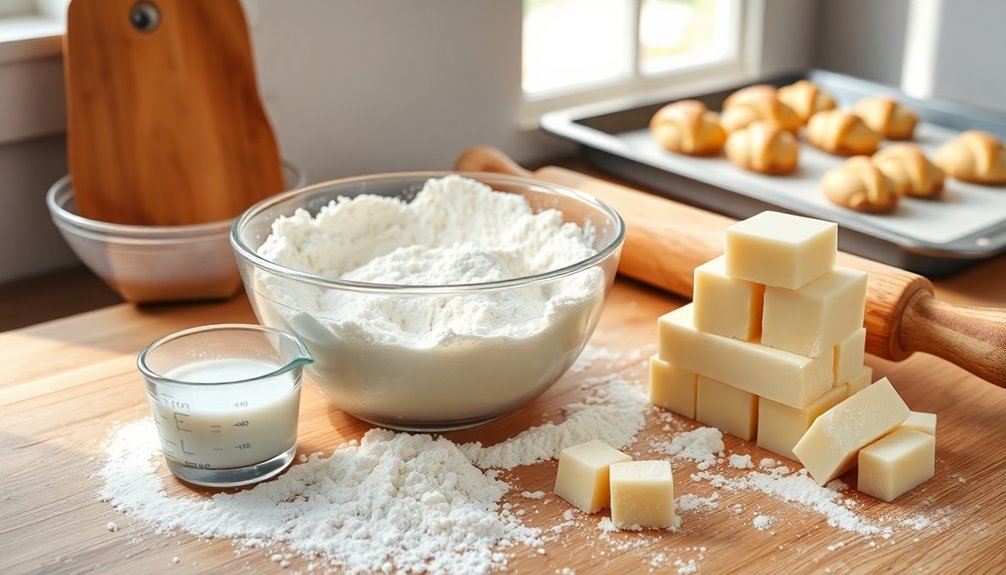
Ingredients:
- 4 cups all-purpose flour
- 1/4 cup granulated sugar
- 2 1/4 teaspoons dry active yeast
- 1 teaspoon salt
- 1 1/4 cups cold milk
- 1 cup cold, cubed unsalted butter
- 1 egg (for egg wash)
Cooking Instructions:
In a large bowl, combine the flour, sugar, yeast, and salt.
Mix in the cold, cubed butter until well coated, then pour in the cold milk to form a shaggy dough.
Knead the dough briefly just until it comes together, wrap it tightly, and chill it in the refrigerator for at least 1 hour.
Once chilled, roll the dough into a rectangle and fold it into thirds.
Repeat this rolling and folding process 4-5 times to create layers.
Shape the dough into croissants and allow them to proof in a draft-free area for 1.5 to 2 hours until puffy.
Brush with an egg wash, then bake at 425°F (218°C) for about 18 minutes, rotating the pans halfway through, until they're deep golden brown.
Allow to cool for 10 minutes before serving.
Extra Tips:
For the best results, make sure all your ingredients are as cold as possible, especially the butter, as this will help create the flaky texture. Additionally, using salted butter can enhance the flavor of your croissants.
When rolling out the dough, try to work quickly to keep the butter from softening.
If the dough becomes too warm, return it to the refrigerator to chill before continuing.
Additionally, experimenting with different fillings, such as chocolate or almond paste, can elevate your croissants even further.
Enjoy the process and don't rush; great croissants take time and care to perfect!
Cooking Steps
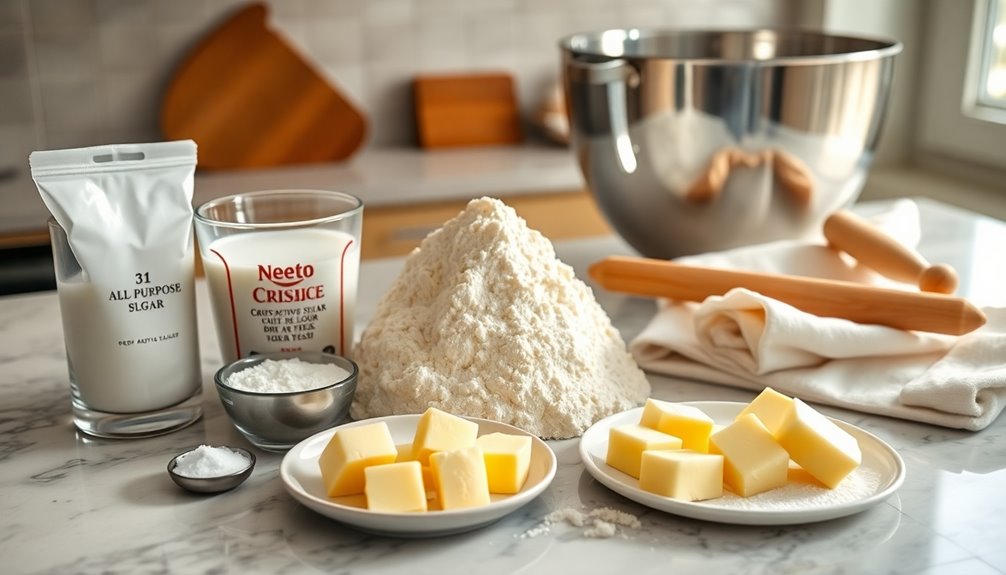
Now, let's get into the cooking steps for your homemade butter croissants.
You'll start by preparing the dough mixture and chilling it thoroughly to build that perfect texture.
After that, you'll roll and fold the dough to create those delightful flaky layers, so let's get started!
Step 1. Prepare the Dough Mixture
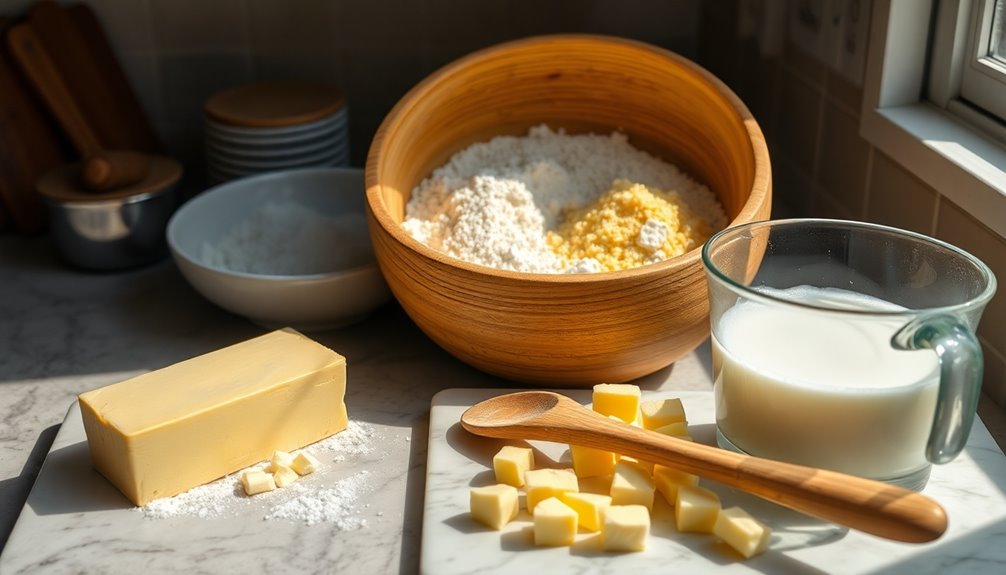
To kick off preparing your dough mixture, start by combining cold ingredients in a large mixing bowl. Add all-purpose flour, granulated sugar, dry active yeast, and salt, ensuring the yeast activates properly without overheating.
Next, cut high-quality cold butter into small cubes and mix it into the flour until each piece is coated, which helps create flaky layers. Gradually stir in cold milk to form a shaggy dough, keeping the temperature low to prevent the butter from melting.
Knead the dough just until it sticks together, being careful not to overwork it. Finally, wrap it tightly in plastic wrap and chill for at least 1 hour. This resting period enhances the dough's flavor and texture, preparing it for the next steps.
Step 2. Chill the Dough Thoroughly
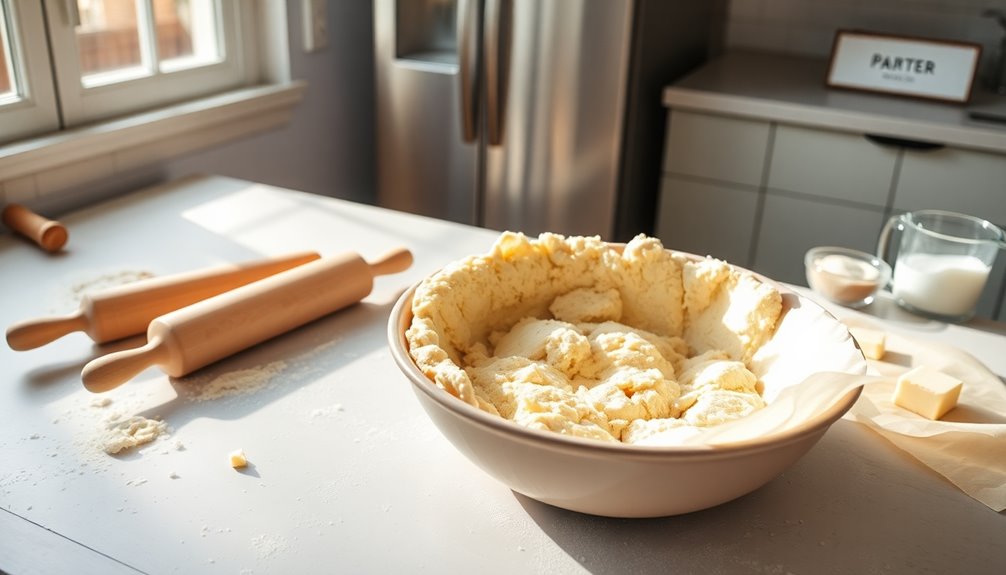
Once your dough has chilled for the first hour, it's time to focus on the rolling and folding process.
To ensure your croissants achieve that perfect flaky texture, you must chill the dough thoroughly between each turn. After each rolling and folding, refrigerate the dough for at least 30 minutes. This allows the gluten to relax, making it easier to shape.
Keep the dough's temperature below 60°F (15°C) to prevent the butter from melting into the dough, ensuring distinct layers of dough. If the dough feels warm or sticky, return it to the refrigerator to cool down.
Proper chilling times are vital for enhancing the croissant's structure, contributing to a better rise and flakiness during baking.
Step 3. Roll and Fold the Dough
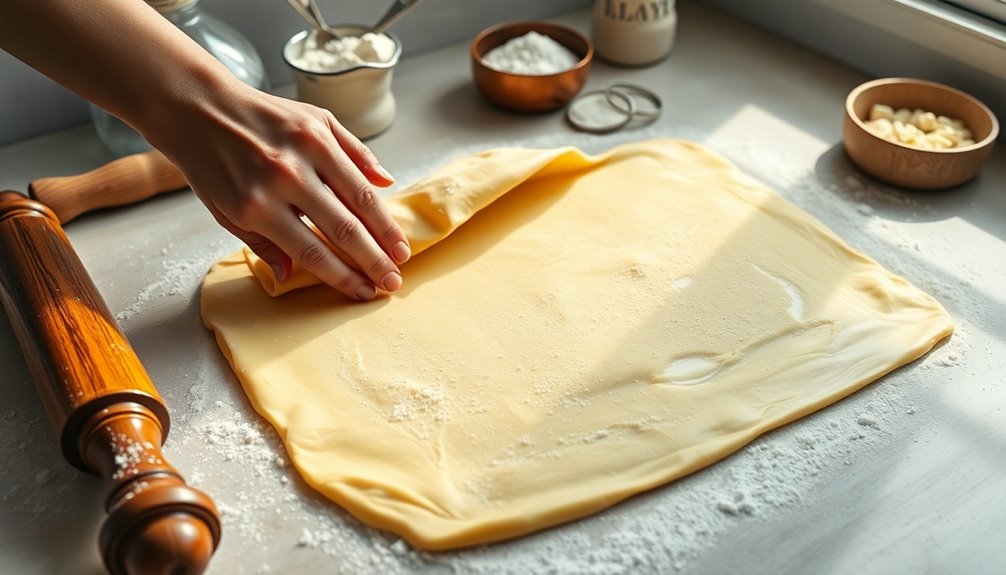
As you prepare to roll and fold the dough, make sure it's chilled and ready to create those flaky layers.
Begin by rolling the dough into a long rectangle, aiming for dimensions of about 24 x 8 inches. Next, fold the dough into thirds like a letter, aligning the edges to encase the butter layers properly.
After this, refrigerate for about 20 minutes to allow for resting time and gluten relaxation.
Repeat the rolling and folding process two more times, chilling the dough between each turn to maintain the cold temperature necessary for lamination.
Finally, roll the dough out to approximately 8 x 44 inches, trim the ends for straightness, and cut it into triangles to shape croissants into their signature crescent shape.
Step 4. Proof the Dough Thoroughly

After you've shaped the croissants, it's crucial to proof the dough thoroughly for the best results.
Place the shaped croissants in a warm, draft-free environment for about 1.5 to 2 hours. Cover them with a damp cloth or plastic wrap to prevent drying out.
During this time, the dough should rise until it appears jiggly and visibly puffy, indicating that the yeast has properly activated. Aim for the dough to have doubled in size; this means you'll achieve that light, airy texture essential for flaky layers.
Make sure the dough is at room temperature before baking, as cold dough can lead to undercooked centers and a dense texture.
Enjoy the process; good proofing is key!
Step 5. Bake Until Golden Brown
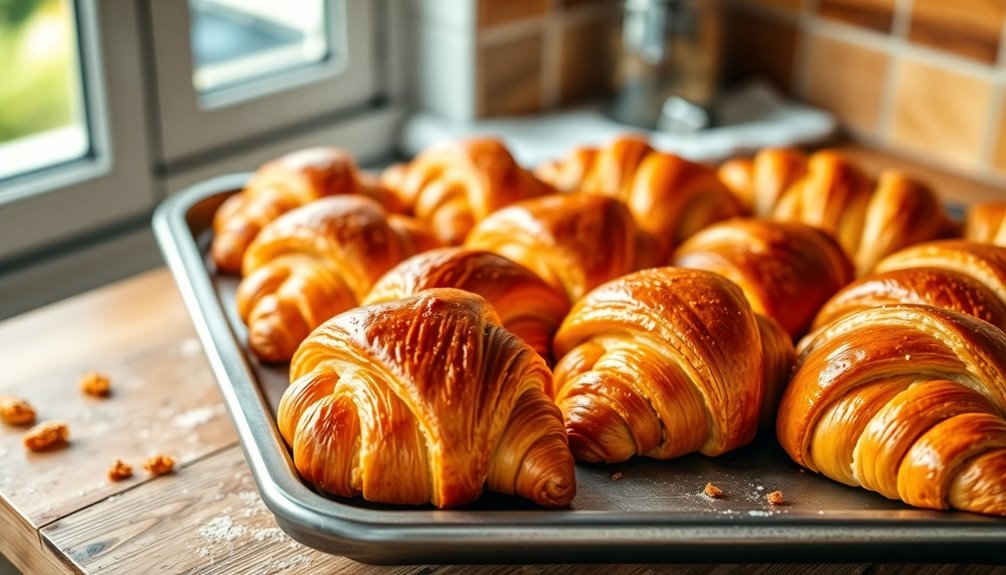
With the dough perfectly proofed and ready, it's time to bake those croissants to golden perfection.
First, preheat your oven to 400°F (204°C) and position the rack in the bottom half for even baking.
Brush the shaped croissants with an egg wash, creating a glossy finish that enhances their appeal.
Bake the croissants for about 20 minutes, rotating the pans halfway through to ensure even browning.
Keep an eye out for a deep golden brown color; this indicates that the layers have puffed and flaked beautifully.
Once baked, allow the croissants to cool for about 10 minutes.
This resting period helps maintain their flaky texture, making them irresistible when served warm.
Enjoy your homemade baked croissants!
Final Thoughts
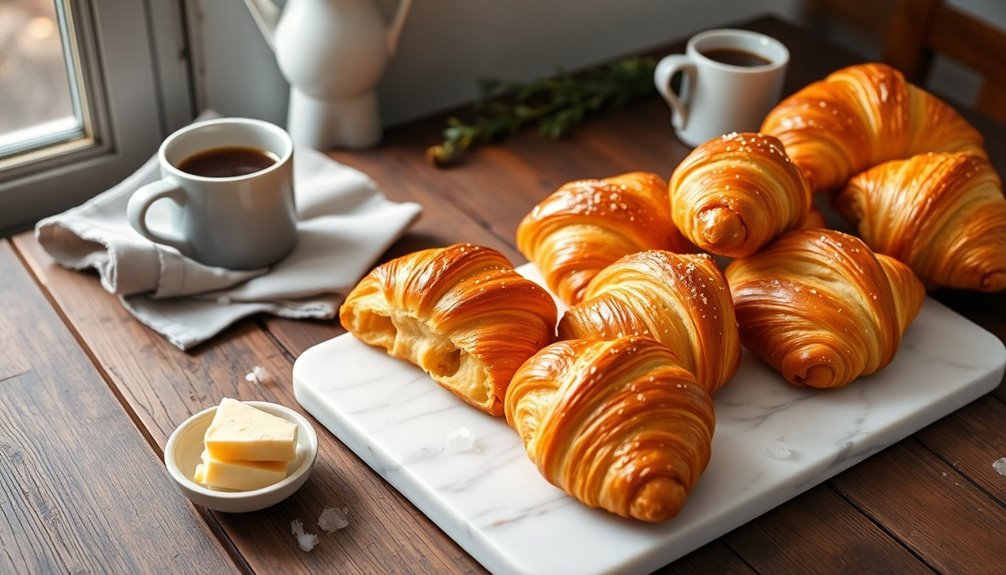
Homemade butter croissants can be a rewarding baking project that elevates your culinary skills. By mastering the art of laminating the dough, you'll create those signature flaky layers that make these pastries irresistible.
Using European-style butter enhances the buttery flavor, giving your croissants a rich, tender texture. Don't underestimate the importance of resting times; allowing the dough to rise properly is crucial for achieving a light, airy final product. Additionally, incorporating cultured butter can further enhance the flavor profile and provide a unique tanginess.
Proper proofing, ideally lasting between 1.5 to 2 hours, ensures puffiness during baking. Remember, fresh baked croissants are best enjoyed right away, but you can store them at room temperature or freeze for later.
With practice, you'll be savoring your homemade pastry like a true artisan!
Frequently Asked Questions
How to Make Croissants Step by Step?
To make croissants, start by mixing flour, sugar, salt, and yeast with cold milk.
Knead until the dough's soft and slightly tacky, then refrigerate for 30 minutes.
Create a butter layer by softening butter with flour and chilling it.
Roll out the dough, place the butter inside, and fold.
Perform three turns, rolling and cutting it into triangles.
Shape each triangle, let them proof, then bake until golden brown and flaky.
Enjoy!
What Are the Ingredients in Croissant Dough?
You know what they say, "Good things come to those who bake."
When you're making croissant dough, you'll need a few key ingredients. Start with all-purpose flour for structure, add granulated sugar for a touch of sweetness, and sprinkle in some salt for flavor.
Don't forget active dry yeast to help it rise. Finally, high-quality cold butter, cut into small cubes, is crucial for achieving those flaky layers you crave.
What Is the Difference Between a Croissant and a Butter Croissant?
The main difference between a croissant and a butter croissant lies in the butter content.
While all croissants are buttery, butter croissants use higher-quality, European-style butter with around 82% fat, making them richer and flakier.
You'll notice the texture is more tender and the flavor more indulgent.
What Is the Best Flour for Croissants?
Did you know that using the right flour can make or break your croissant, with protein content playing a crucial role in texture?
For the best results, opt for all-purpose flour for its balanced protein level, or choose bread flour for a chewier texture.
European-style flours, like Type 55, are favored by pros for their superior quality.
Just steer clear of cake flour to avoid dense, unflaky croissants.
Quality matters, so choose wisely!



